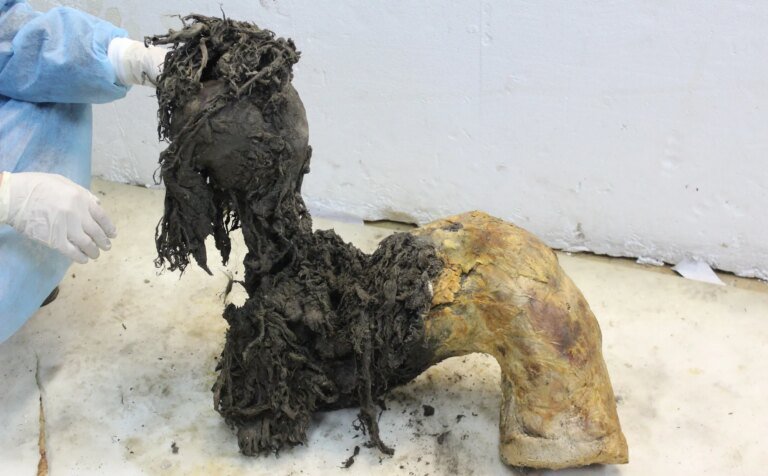A 40,000-year-old juvenile woolly mammoth named Yuka is not only remarkable because she was uncovered nearly intact or her grisly cause of death. Her muscles provided paleogeneticists with the oldest known RNA sequences ever recovered. Detailed in a study published on November 14 in the journal Cell, the samples contradict previous assumptions about the genetic material’s resilience while furthering our understanding of the famous, extinct megafauna.
Although the last woolly mammoths succumbed to a warming planet around 4,000 years ago, the vast majority of them lived and died during the last Ice Age. Paleontologists have since exhumed multiple specimens in regions like Siberia, where the frozen tundra and permafrost often keeps the remains remarkably well preserved.
Of those, one woolly mammoth stands apart from all others. In 2010, local tusk hunters discovered the nearly intact remains of a juvenile near the coast of the Dmitry Laptev Strait in Siberia. Later nicknamed Yuka, the specimen still features much of its fur, as well as remnants of its tusks, trunk, and small ears. Even at almost 10 feet tall and weighing nearly five tons, Yuka likely died during an attack by cave lions. She’s remained the gold standard of woolly mammoths for nearly 25 years, and consistently provides researchers with new insights about the species and its genetic makeup.
The latest RNA revelations come from a collaboration between researchers at Stockholm University and the Swedish Museum of Natural History. RNA, short for ribonucleic acid, is a polymeric molecule responsible for gene expression and is vital to most biological functions.

“With RNA, we can obtain direct evidence of which genes are ‘turned on,’ offering a glimpse into the final moments of life of a mammoth that walked the Earth during the last Ice Age,” paleogeneticist and study coauthor Emilio Mármol said in an accompanying announcement. “This is information that cannot be obtained from DNA alone.”
For years, researchers assumed gleaning that type of genetic evidence from a woolly mammoth to be nearly impossible. Although the ability to recover DNA and certain other proteins now extends past one million years, RNA was long thought too delicate to survive even a few hours after death. Mármol and his colleagues suspected otherwise, however.
“We wanted to explore whether we could expand RNA sequencing further back in time than done in previous studies,” explained Stockholm University evolutionary genomist and study coauthor Love Dalén.
Mármol, Dalén, and their collaborators knew that if any ancient specimen still possessed any RNA, it would be a well preserved mammoth like Yuka. After examining samples of her frozen muscle, Mármol’s team scoured over 20,000 protein-coding genes, many of which were inactive. They eventually identified RNA molecules responsible for coding key protein functions in muscle construction and stress-related metabolic regulation. These discoveries added further evidence to the theory of Yuka’s final moments.
“We found signs of cell stress, which is perhaps not surprising since previous research suggested that Yuka was attacked by cave lions shortly before [her] death,” said Mármol.
Apart from the RNA itself, the scientists also located microRNAs that don’t encode for proteins.
“[MicroRNAs] were among the most exciting findings we got,” said molecular bioscientist and study coauthor Marc Friedländer. “The muscle-specific microRNAs we found in mammoth tissues are direct evidence of gene regulation happening in real time in ancient times. It is the first time something like this has been achieved.”
“Our results demonstrate that RNA molecules can survive much longer than previously thought,” added Dalén.
Dalén added that the team now believes they will soon be able to examine the “turned on” genes in other extinct animals, but the advancements don’t only concern creatures from the distant past. Further breakthroughs could help sequence RNA viruses like Ice Age-era influenza and coronaviruses.



